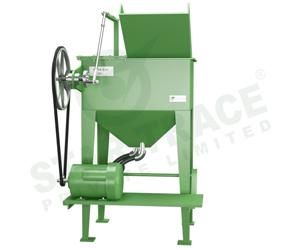
Laboratory Mineral Jig

Jigging is the process of separating the particles of different specific gravity, size and shape by introducing them on screen though which a fluid is made to pulsate alternately.
It is consists of a rectangular open top container. The bottom of the container is either a screen or a perforated surface which supports the bed of the solids. Pulsion and suction strocks of water through the screen are given by means of a reciprocating piston. During the pulsion stroke, solid bed is opened and the particles are lifted. The particles settle into more homogeneous layer during the suction stroke. By repeated pulsoin and suction stroke, a complete stratification is achieved with the heavy particles at the bottom and lighter particles above them.
The following three effects contributes to the stratification in Jig:-
1. Hindered settling classification.
2. Differential acceleration at the beginning of fall.
3. Consolidation trickling at the end of the fall.
Technical Specification:
| Model | Area | Stroke | Times of Stroke | Feed Size | Capacity | Feedwater Flow Control | Power | Overall Dimension | Weight |
| m2 | mm | r/min | mm | t/h | m3/h | kw | mm | t | |
| JT1-1 | 1 | 8.5-12 | 80-180 | <6 | 2-4 | 0.05 | 2.2 | 1630/1310/2010 | 0.9 |
| JT2-2 | 2.28 | 12-17 | 80-180 | <10 | 4-8 | 1-3 | 3 | 3220/1550/2050 | 1.6 |
| JT3-1 | 3.3 | 80-120 | <10 | 6-10 | 1�-3 | 5.5 | 3180/1850/2600 | 3.26 | |
| JT4-2 | 4.33 | 6.5-25 | 80-120 | <30 | 10-15 | 1-2 | 7.5 | 3600/1850/2600 | 4.6 |
| JT5-2 | 4.86 | 15-25 | 80-120 | <10 | 10-20 | 1-2 | 7.5 | 3600/2000/26000 | 4.8 |
| LTA1010/2 | 4 | 0-26 | 250-350 | 1-6 | 2-20 | �1-2 | 2.2 | 2800/1800/2300 | 1.3 |
| 300/450 Diaphragm | 2.7 | 0-26 | 320 | 12 | 3-6 | 2- 3 | 1.1 | 1230/1270/1750 | 0.74 |
| 370/360 diaphragm | 2.75 | 5-25 | 2-5 | 6 | 1- 3 | 2- 3 | 1.1 | 1000/6000/1600 | 0.24 |
